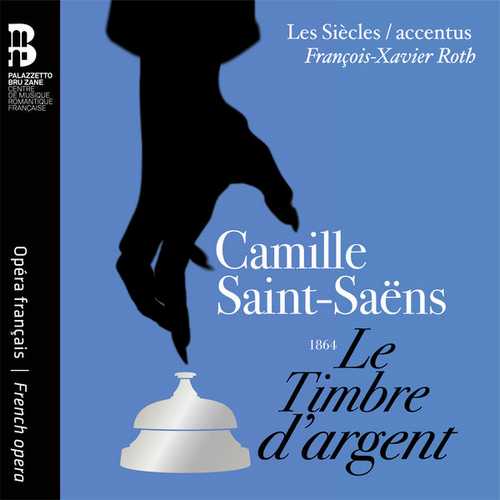

Composer: Charles Camille Saint-Saëns
Performer: Yu Shao, Jodie Devos, Edgaras Montvidas, Hélène Guilmette, Tassis Christoyannis, Jean-Yves Ravoux, Matthieu Chapuis
Orchestra: Les Siècles, Accentus
Conductor: François-Xavier Roth
Number of Discs: 2
Format: FLAC (tracks)
Label: Bru Zane
Catalogue: BZ1041
Release: 2020
Size: 679 MB
Recovery: +3%
Scan: yes
Le Timbre d’argent
CD 01
Acte I
01. I. Ouverture
02. II. Scène. Nuit d’ivresse et de fête !…
03. III. Scène. Eh bien ?
04. IV. Choeur. Ô vain mirage !
05. V. Scène. Quoi ? Vous partez ?
06. VI. Prière. Ô Vierge mère
07. VII. Scène. Bénédict, quelles sont ces clameurs ?
08. VIII. Mélodie. Humble et pauvre, es-tu donc heureux ?
09. IX. Scène. Non, non ! que parles-tu d’unir à ma détresse
10. X. Scène. Carnaval ! Carnaval !
11. XI. Air. Dans le silence et l’ombre
12 .XII. Scène. Carnaval ! Carnaval !
13 .XIII. Choeur. Circé ! renais à la vie
14. XIV. Scène. Ô rêve d’amour !…
Acte II
15. I. Premier tableau. Entracte et Choeur. Gloire à la belle
16. II. Premier tableau. Scène. Un collier manquait aux atours
17. III. Premier tableau. Pas de l’abeille et Scène. Fiametta !
18. IV. Premier tableau. Scène du jeu. À vous les dés, marquis
19. V. Premier tableau. Scène. Pardon, ami Conrad
20. VI. Premier tableau. Romance. Le bonheur est chose légère
21. VII. Premier tableau. Scène. Dieu ! j’ai cru…
22. VIII. Deuxième tableau. Choeur et Scène. Séduisante almée
23 .IX. Deuxième tableau. Chanson napolitaine et Scène. Qui je suis ?
24. X. Troisième tableau. Scène. Ô merveille !
25. XI. Troisième tableau. Finale. Dans le bruit et dans l’ivresse
CD 02
Acte II
01. XII. Troisième tableau. Finale (Suite). Vivat ! vive le vin
Acte III
02. I. Prélude
03. II. Choeur. Voici le seuil hospitalier
04. III. Scène. La voici, mes amis
05. IV. Scène et Duo. C’est là, là que mes mains
06. V. Scène. Pardon, seigneur Conrad
07. VI. Scène. Quel trouble s’empare
08. VII. Scène. Bien joué !
09. VIII. Duo. L’humble papillon de nuit
10. IX. Scène. Holà, mes amis !
11. X. Choeur. Plus vive que l’oiseau
12. XI. Finale. Ha ! Heiza !
Acte IV
13. I. Premier tableau. Scène. Quelle invisible main me pousse
14. II. Deuxième tableau. Choeur et Scène. Carnaval ! Carnaval !
15. III. Deuxième tableau. Scène. L’oiseau perdu dans l’espace
16. IV. Deuxième tableau. Ballade. Sur le sable brille
17. V. Deuxième tableau. Scène. À moi ! filles d’enfer !
18. VI. Deuxième tableau. Scène. Que me veux-tu ?…
19. VII. Deuxième tableau. Scène. Je ne suis qu’une humble fille
20. VIII. Deuxième tableau. Scène et Trio. Hélène !
21. IX. Deuxième tableau. Scène. Mais non
22. X. Troisième tableau. Ô Vierge mère
23. XI. Troisième tableau. À vous mon âme !
Saint-Saëns’s first opera, Le Timbre d’argent initially composed in 1864 need not fear comparison with some of the most celebrated works in the nineteenth-century French repertory. It depicts the nightmare of a man whose hallucinations anticipate by twenty years the fantastical apparitions of Offenbach’s Les Contes d Hoffmann. A manipulative diabolical figure gives the hero a silver bell that he must ring to obtain the gold that will enable him to gain the love of the beautiful Circé; in exchange, a supposedly random victim must perish. But first Conrad’s father-in-law, then his best friend are the ones to die. The flashback that resolves the drama already prefigures the cinematic devices of the following century. Le Timbre d’argent is presented here in its final version, dating from 1914, the last of ten revisions over a period of almost fifty years. The dynamic conducting of François-Xavier Roth and the exceptionally precise and fiery performance of the period-instrument orchestra Les Siècles demonstrate that Saint-Saëns was doubtless right to persist in considering the work as one of his masterpieces.
Le Timbre d’Argent (The Silver Bell), begun in 1864, was Camille Saint-Saëns’ very first opera. All but forgotten, it was last staged in 1914, before the 2017 Paris production on which this 2020 release is based. The forces here, including the specialist ensemble Les Siècles, the fine choir Accentus, and conductor François-Xavier Roth make a strong case for the opera’s revival. Saint-Saëns obviously valued the work, revising it as late as 1913, due in part to the Franco-Prussian War; it is this last version that is heard presently. The work was termed a drame lyrique or opéra fantastique rather than an opéra comique, but it is an action-packed work that veers between romantic fun and fantasy elements that it shares, along with a pair of librettists, with Offenbach’s Les contes d’Hoffman of 15 years later. (Goethe’s Faust is another inspiration: the titular silver bell brings wealth but kills someone close to the user.) The fantasy elements are prominent in the substantial choral sections, giving the magical choir Accentus much to do. There is a great deal of sheer, sparkling Mozartian melody as well. Roth and a lively cast led by tenor Edgaras Montvidas as the obsessed, Faust-like artist keeps things moving along. Saint-Saëns is a conductor whose star seems to be on the rise, and admirers of his music are sure to want this. The surprise, however, is that anyone can enjoy it.